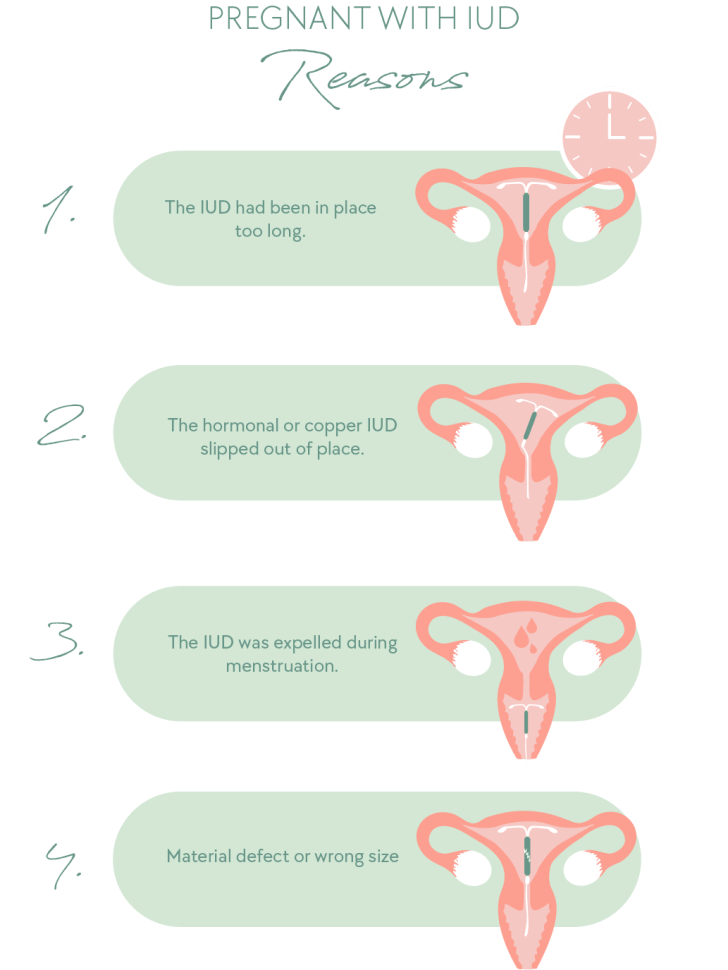Can You Get Pregnant Despite IUD? Things You Need to Know:
- You can get pregnant with an IUD (Copper IUD or Hormonal IUD). The probability of getting pregnant while using an IUD is extremely low, but it is nonetheless possible. Reasons include the IUD slipping out of place, having the IUD in place for too long, and material defects.
- In case of pregnancy, have the IUD removed as soon as possible to avoid complications.
- If you suspect you are pregnant or are unsure how to proceed, this article is for you.
- 🤰🏻 Am I pregnant? — Take the Online Pregnancy Test!
- ⚖️ Should I get an abortion? — Take the Abortion Test!
What Is the Likelihood of a Pregnancy with IUD?
IUD stands for IntraUterine Device. This kind of contraceptive is directly inserted into the uterus by a medical professional.
It is possible to become pregnant, no matter the type of IUD used.
The likelihood of becoming pregnant despite using contraceptives is rated by the Pearl Index (PI). The Pearl Index* counts the number of women who become pregnant, despite having used a particular method of contraception for twelve consecutive months.
-
The Pearl Index for the copper IUD is between 0.3 and 3, meaning up to three in 100 women become pregnant each year despite copper IUD.
→ More information on copper IUDs -
The Pearl Index for using a copper chain is 0.1 to 0.8. This means 1–8 in 1000 women become pregnant while using the copper chain for contraception.
→ More information on copper chain IUDs -
Conclusive studies on the reliability of the copper ball are not yet available. However, the Pearl Index is assumed to be similar to the copper IUD or the copper chain. According to the manufacturer, the Pearl Index is 0.5 to 0.7, meaning five to seven women in 1000 become pregnant despite using the copper ball.
→ More information on copper ball IUDs -
Here the Pearl Index is 0.3–0.7. This means three to seven women in 1000 who use a gold coil for contraception still become pregnant each year.
→ More information on the Gold T® IUD -
The Pearl Index for hormonal IUDs is 0.05–0.3. This means up to 3 in 1000 women will become pregnant while using a hormonal IUD.
→ More information on hormonal IUDs -
Stainless steel rings are far less effective than all other IUDs. Therefore, they are no longer in production. Since the SSR stays in place for up to 20 years, some women still use this contraceptive method.
*Various studies with differing data on the Pearl Index are available. We use the information provided by AMBOSS.
Causes — Four Possible Reasons
Here are four possible reasons for becoming pregnant despite an IUD:


-
Depending on the model, a copper IUD can usually remain in the uterus for up to five years. By then, the supply of copper ions, which prevent pregnancy by affecting sperm and uterine lining, is depleted. The same holds true for the copper chain and the copper ball.
Depending on the model, hormonal IUDs can remain in the uterus for three to five years. The artificial hormone, progestin, is then depleted, and the IUD can no longer affect the cervical mucus or uterine lining.
-
The fit of the IUD can be checked using the removal strings, which hang out of the cervix toward the vagina. The IUD may have slipped too far into the uterus if the strings are no longer present. If the strings are longer than usual, the IUD may have slipped too low.
Copper IUDs slip in 1–3% of cases. Therefore, your gynecologist will inspect the position of the IUD during your regular check-ups. If your IUD is not positioned correctly, you may become pregnant.
-
Hormonal and copper IUDs (including copper chains and copper balls) can be expelled during your period without you even noticing.
The odds of this happening are exceptionally high in the first few months after the IUD has been inserted: This occurs in 0.5 to 10% of predominantly young women. The likelihood is even greater if the IUD was inserted after giving birth: 12 - 31% of women lose the IUD without noticing it.
If the IUD strings are no longer tangible, or your menstruation is suddenly stronger than usual, your IUD may have come out.
-
Due to material defects, an IUD can break, causing it to no longer be correctly positioned in the uterus.
The doctor also has to select the correct size of the IUD. This is determined according to the uterus's size, shape, and position. If the wrong size of IUD is selected, the IUD may not fit properly. Note: Some countries, such as the US, do not provide smaller sizes.
Am I Pregnant Despite Having an IUD?
"How do I notice a possible pregnancy despite having an IUD? What are signs of pregnancy despite an IUD?" Perhaps you are currently asking yourself these exact questions. Maybe your period is overdue, despite your IUD.
Think about the reasons that make you suspect you are pregnant.
Is your period late, even though it is usually on time?
This is not necessarily a sign of pregnancy since hormonal IUDs interfere with one's menstrual cycle. Therefore, periods can become irregular or stop altogether. Copper IUDs can have the opposite effect: Women's natural cycles usually continue, and periods may become more frequent, especially initially after insertion. Factors such as stress or medication can also affect the woman’s delicate cycle, causing a delay.
🤔 Could my symptoms be early signs of pregnancy? Take our free online test!
Are you experiencing typical pregnancy symptoms, despite IUD?
It may be a relief to know that even common signs of pregnancy, such as nausea or abdominal pain, do not necessarily signify a pregnancy. Nonetheless, it is wise to analyze your symptoms or seek medical advice. Even with an IUD, you can still take a home pregnancy test to gain some certainty. The article How Does a Pregnancy Test Work? provides information on when and how to take the test.
Are you experiencing unusual symptoms or pain?
It is also possible that a pregnancy has come about which is not intact.
Unplanned Pregnancy Despite IUD — Tips
Maybe the news of being pregnant came utterly unexpected. After all, you have been using the IUD for years without thinking anything of it. This initial shock can be profound. Thousands of thoughts, unanswered questions, and emotions are whirling inside you.
Here are four suggestions on how to digest the news and what to do next:
1. 👩⚕️ Go to the doctor and have the IUD removed.
If you are pregnant and your IUD is still in place, it needs to be removed by your doctor as soon as possible. Removing the UID avoids complications such as infections. Leaving a hormonal IUD in place may also harm the child or lead to miscarriage.
2. 🕰 Take the time you need before making a decision.
It takes some time for the news of an unplanned pregnancy to sink in. Take the time you need for the storm raging inside you to subside and to sort through your thoughts and emotions. By doing so, you can ensure that you choose the path that corresponds to your true desires.
3. 👤 Seek out the support of others.
Your situation is not uncommon. Many women have shared their experiences and fears concerning a pregnancy despite IUD. You do not have to face your fears alone! Seek a dependable friend or family member with whom to share your considerations and concerns.
- ⛑ Where do I go from here? — Quick Answers Quiz: While this does not replace real-time conversations, it gives you the tools to think through your options and helps you know that others have walked this road before you.
4. 🧡 Focus on your opportunities!
This may help you identify your innermost thoughts and emotions and allow you to gain a new perspective. We desire for you to discover a way forward where your values and intuitions align.
- 🍷🚬 Tobacco/alcohol/drugs: Has my consumption hurt the baby?
- 🧑⚕️ (Maybe) Pregnant: How Soon Should I See a Doctor? Take the Test!
- ⚖️ Abortion: yes or no? — Take our free Abortion Test
- 🧔🏻♂️ How do I react if he does not want the baby?
👤 What is your personality type, and how does this affect your pregnancy? — Take the free Personality Test!
Facts About IUDs
More information about each type of IUD:
-
- The copper IUD is inserted directly into the uterus by the gynecologist.
- If something is located inside the uterus, it is called intrauterine. This is why IUDs are called IntraUterine Devices.
- The copper IUD is T-shaped and consists of a copper wire and plastic. It does not contain any hormones. The contraceptive effect is due to the release of spermicidal copper ions. Copper ions also affect the uterine lining, preventing the implantation of any fertilized egg.
- You can check the position of the IUD at any time by the removal strings that extend through the cervix toward the vagina.
-
- The copper chain, known by the trade name Gynefix®, consists of a nylon string covered with several small copper sleeves. Using a special insertion device, the line is fastened to the muscles of the uterine wall by a small knot to keep the copper chain in place.
- The copper chain works like any copper IUD: The copper ions released by the tubes limit the sperm's fertilizing ability. The uterine wall is also affected. As a result, fertilized eggs are prevented from implanting in the uterine lining.
- Copper chains are not available in the US.
-
- Because the copper ball is also inserted directly into the uterus by a gynecologist, it is also known as an intrauterine ball (IUB).
- Like the copper IUD, this is a hormone-free contraceptive.
- The copper ball consists of a polymer-coated alloy wire threaded with small copper spheres. Upon insertion in the uterus using a special device, it takes the original three-dimensional spherical form.
- The copper ions released have a spermicidal effect and affect the uterine lining, preventing the implantation of a fertilized egg.
- Copper balls are not available in the US.
-
Strictly speaking, the Gold T® is a copper coil with a gold core. While the effect is identical to any other copper IUDs, the gold core prevents the copper wire from premature wear and tear, making it more durable.
Gold Ts are not available in the US. -
- As the name suggests, hormonal IUDs are a type of hormonal contraceptive.
- A hormonal IUD is a t-shaped piece of plastic that the gynecologist inserts into the uterus.
- Hormonal IUDs contain the hormone progestin, which is continuously released into the uterus in small amounts. This causes a thickening of the cervical mucus at the cervix, preventing sperm from passing through. Additionally, sperm cells are inhibited in their ability to move and fertilize. The uterine lining is also thinned, preventing the implantation of a potentially fertilized egg.
-
- Stainless steel rings, known as Chinese rings or Shanghai rings, used to form the backbone of birth control in China.
- The ring is 1” in diameter and does not have a removal string, making its removal difficult, even for a physician. The rationale behind the lack of removal capabilities was the political agenda of the one-child policy in China.
- The ring was used for post-placental insertion, within ten minutes of the delivery of the placenta, after the birth of the first child.
- It is estimated that 50,000,000 women have had a ring inserted.
- Copper IUDs are increasingly replacing the stainless steel ring because of their higher effectiveness and lower infection rates.
FAQs
-
A pregnancy despite an IUD is very rare but still possible. This can happen if the IUD has shifted, has been expelled without being noticed, or has been in place for too long. Once you find out you are pregnant, have your IUD removed as soon as possible. Keeping it in place could lead to complications such as infection, inflammation, and an increased risk of miscarriage. Even if you are unsure whether to continue the pregnancy, it is still advisable to ask for the removal of the IUD.
Caution: The risk of ectopic pregnancy is higher with an IUD in place. If you are experiencing pain or spotting, seek immediate medical attention. -
The typical symptoms of pregnancy also apply to pregnancy with an IUD, such as nausea, breast tenderness, or a missed period. If you are experiencing signs of pregnancy, especially if your period is late, take a pregnancy test or see your doctor to gain clarity. For an initial evaluation, take Profemina's Online Pregnancy Test. Should you be pregnant while the IUD is still in place, have your doctor remove it as soon as possible. An IUD would increase the risk of an ectopic pregnancy and other complications.
-
Getting pregnant despite an IUD is very rare but not impossible. It can occur if the IUD has slipped, has stayed in the uterus too long, or has fallen out. A woman usually notices a pregnancy by typical pregnancy symptoms, including a missed period. Should you experience light bleeding while pregnant, this is not your menstruation. Rather, the bleeding is most likely triggered by implantation. For more information, go to the Profemina article Period while Pregnant.
Note: Seek medical attention if you feel unsure about your symptoms, are experiencing unfamiliar pain, or are spotting. You may be having an ectopic pregnancy, which is more common with IUDs.

















